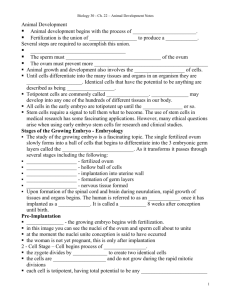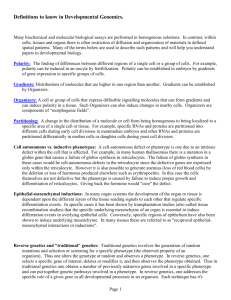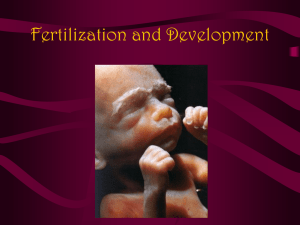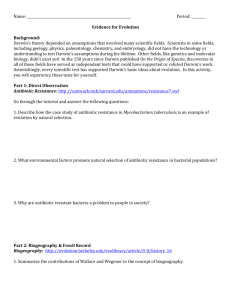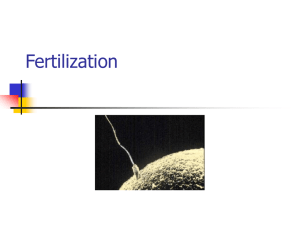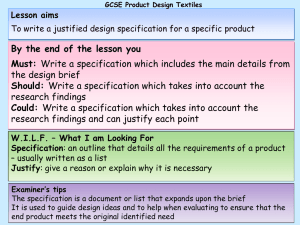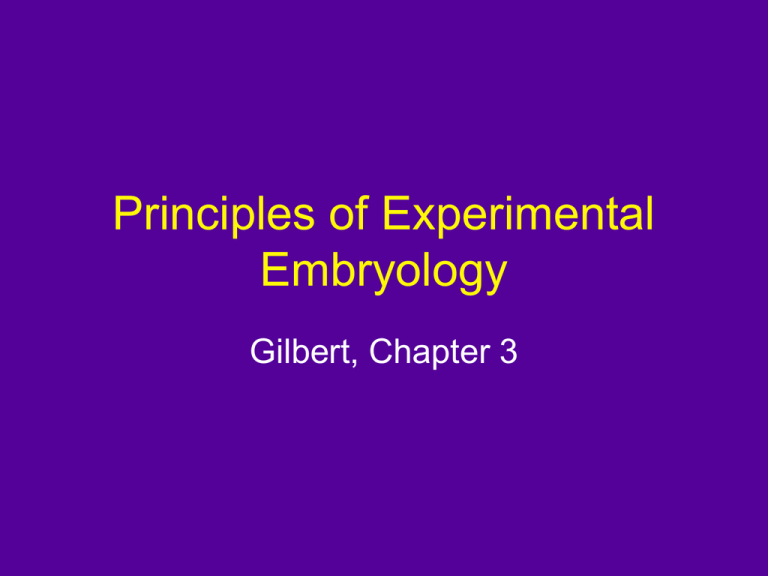
Principles of Experimental
Embryology
Gilbert, Chapter 3
Today’s Objectives
• Identify the current ways in which
developmental biologists approach basic
questions
• Discuss the fact that Dev. Bio. Has
implications and overlap for many areas of
science
• Define: differentiation, determination,
specification
• Define Autonomous and Conditional
Specification
What questions do
researchers in Dev. Bio. Ask?
• Historically
– What happens?
– When does it happen?
– Where does it happen?
• Modern Dev. Biologists:
– HOW?
– 1894 - Wilhelm Roux Entwicklungsmechanik - Developmental
Mechanics
3 Major Areas of Dev. Bio.
Research
• 1) How does the outside world influence
embryo
– Environmental, medical embryology (teratology)
• 2) How do forces INSIDE the embryo
encourage cells to differentiate?
• 3) How do cells organize into tissues and
organs?
Environmental Developmental
Bio.
• Environment plays a major role in the
development of an organism
• Early embryologists:
– Alter environment to see if affect
phenotype of embryo
– Environment could play a role in the ways
genes respond and organism develops
Example: Sex Determination in
a Vertebrate: Alligator (p. 50)
• Depends not on chromosomes, but on
temperature! (Ferguson and Joanen)
• During 2nd and 3rd week of incubation
– Eggs incubated at 30ºC or below =>
Females
– Eggs incubated at 34ºC or above =>
Males
– At temps between these, mixture of males and
females (see p. 50)
• Also reflects upon the environment where
eggs are laid/incubated
– Nests near water - cooler -> females
– Nests need levees - warmer -> males
• Another effect - NOT a 1:1 sex ratio in nature
– 10:1 ratio of females to males!
– Why is this beneficial?
• Lastly - effects wildlife management &
environmental policies
• What other environmental or ecological
factors do you think could affect
embryonic development?
2) How do forces inside the
embryo influence cell
differentiation? (p. 53)
• We’ll see MANY examples of this
throughout the course
• FIRST! Some new terms. . .
Differentiation: cell type is specialized
and performs specific function
– Usually irreversible
Process of Cell Commitment
• Cells are said to become “committed” to
a certain fate
– Haven’t yet BECOME that differentiated
cell, but are restricted from being other cell
types
• 2 phases . . .
Phases of Cell Commitment
(p. 53)
• Specification: Cells begin to go toward a
differentiated cell type, but this is reversible
– Cells are able to differentiate into that cell type if
cultured in vitro (and away from other cells)
• Determination: Cells are further toward
differentiated, but are not functioning as the
final cell type. Irreversible
– If move cells to NEW area of embryo, they will
develop as if in ORIGINAL location.
2 Types of Specification
• Autonomous (kind of like Independent)
– Cells can differentiate on their own, into
their final cell types
• Conditional (kind of like Dependent)
– Cells must interact with other cells/or their
environment to differentiate properly into
their final cell type
Autonomous Specification
(p. 53)
• Example
• Remove certain cells from a Patella
(mollusc) embryo
• Those cells grow cilia, just as they
would have in the normal embryo
http://www.theseashore.org.uk/theseashore/speciespages/Limpets.jpg.html
Patella vulgata (common
Limpit)
• Peach colored cells are Autonomously
Specified to grow cilia
Conditional Specification
• Involves interactions from neighboring
cells
• Each cell still has ability to become
more than 1 differentiated cell type
• Surrounding or neighboring cells
provide signal to restrict the fate of
those cells
Conditional Specification
Example (p. 58-59)
• Remove blastomeres from early frog
embryo
• Transplant from Dorsal (Back) side to
Ventral (belly) side
– The cells that were transplanted become
Belly
– What can we conclude about the
commitment of those original cells before
transplant?
Conditional Specification
• We’ll see many examples of both
Autonomous and Conditional of
specification as we investigate how
embryos develop
• Important terms to recall throughout the
semester
One more Idea . . .
• Early embryologists had different views
with regard to how early on cells were
specified and whether cells were
totipotent
Mosaic development
• Each cell is preprogrammed, and
removing 1 cell will result in a defect in
the embryo
Regulative Development
• If you remove cells from an embryo, that
embryo will fill in for the missing cells
– Fills in the blanks
– Won’t be any smaller in size, or missing
any pieces
– How will the cells know what to replace?
3) How do cells organize into
tissues and organs?
• Many questions!
• How are tissues formed?
• How are organs constructed from
tissues?
• How do organs get to their particular
locations?
• How do organs grow?
• How do organs get polarity?
Lots of answers!
• We’ll see examples throughout the
course as we examine specific organs
– Limb -really interesting and wellunderstood
• For now, let’s start with - cells need to
stick together to make tissues
Differential Cell Affinity
• Certain cells have molecules (like
proteins, glycoproteins) on their surface
that allow them to stick (adhere) to other
cells
• Important inside the embryo
– Cells that are going to coordinate to make
a tissue or organ have to be able to stick
together!
Fig. 3.23 (p. 68)
• Cells can sort according to their affinity
to adhere to other cells (stick)
– Here according to Germ layers (endoderm,
ectoderm, mesoderm
• Again, this is essential in embryonic
development and we’ll see it often in our
lessons



